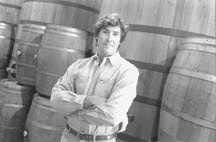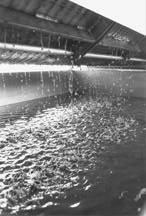Small Is Good
Cask Away: Byington Winery's Alan Phillips and his aging wine.
With the crush of 1996 almost over, two local winemakers believe that quality, not quantity, will be this year's hallmark
By Christina Waters
A YEAR AND A HALF from now, when those first bottles of vintage 1996 wines hit the shelves, consumers will probably notice two things. The first will be a higher price tag for that bottle of cabernet sauvignon. Assuming that wine lovers have patience and don't pop their corks too soon, the other noticeable feature of 1996 wines will probably be high quality.
Even without a crystal ball, it doesn't take a business genius to grasp the reason for projecting higher wine prices in the near future. Supply and demand continue to reign as economic indicators, and the harvest of 1996 was down, in the case of some varietals, by as much as 50 percent. Fewer grapes, or lighter grapes, means less juice. Less juice, less wine.
"Our zinfandel crops are down about 20 percent," says Ridge winemaker Paul Draper. "But the quality looks superb. The color is dark, there are more tannins compared with other vintages." And according to the man who makes arguably the finest zinfandel in California, this year's increased tannin means more structure in the finished product. Does that mean a rough ride on the palate? Draper chuckles. "We'll be bottling this year's harvest in a year and a half, and by the time they're aged out they'll be as soft as other vintages."
Draper explains that zinfandel, a grape that loves warm weather and hence is grown by Ridge up in sunny vineyards at Lytton Springs and Geyserville, tends not to be as high in tannin as, say, cabernet sauvignon. And even in a year where tannins are increased, as in this particular year, "the richness in zinfandel can carry most tannin." So you might have to hold on to that bottle of Geyserville Zinfandel a bit longer than usual (in my house, Ridge zins "age" for roughly 20 minutes), but when you do open it, prepare to be thrilled.
Photo by Christopher Gardner
Ridge Winery cabernet sauvignons, chardonnays and merlots are grown on the 110-year-old estate vineyard at Montebello Ridge above Cupertino. "As far as our cabernets go," Draper sighs, "we're down 40 percent." Unusually fine weather followed last spring's late rains. "So the vines flowered and set fruit earlier than usual," Draper says. "But then during set there was sudden cold weather. Then it was warmer than we like--so essentially not as much fruit formed."
This climatic rollercoaster affected the cabernet sauvignon crop. "There were plenty of clusters, so that when we did a cluster count we were optimistic. But once we began harvesting, we saw that the berries were smaller and weighed much less than we'd like."
Draper, whose vineyards utilize St. George rootstock and hence weren't subject to the current epidemic of phylloxera raging through much of California's wine country, has only the weather--not root louse--to blame for this year's shortfall. "We usually produce around 60,000 cases annually of zinfandel and cabernet and their related varietals, and we'll be down this year. How far down I don't know yet--we have one more vineyard to pick."
Draper agrees that this year's grape shortage could very well spell higher prices when the wines are released in the summer of 1997. "Demand is up, and the size of the 1996 vintage will be really down. If most people are going to survive economically, I guess they will need to raise prices. I just hope the quality is there," he adds, "to justify raising prices."
AT BYINGTON WINERY, in the mountains above Los Gatos, winemaker Alan Phillips continues his quest for the great California pinot noir. With half of his harvest already crushed and the other half still awaiting optimum sugar levels, Phillips was enjoying a rare respite in the midst of his busiest time of year. "We've done all our whites and pinot noir--the Santa Cruz Mountains, Central Coast, Santa Lucia Highlands," he recites. "And we're still waiting on our Santa Cruz and Sonoma cabs and the Oregon pinots."
Byington started buying Oregon grapes last year, "when we had trouble with the consistency of our Central Coast source," Phillips explains. "We're pleased with the Oregon grapes. We've gotten consistent tonnage from a vineyard in the Willamette Valley. The grapes are good--unfortunately, not as good as the Santa Cruz Mountains. Whenever we hear of someone wanting to start vineyards in the Santa Cruz Mountains, we tell them, 'Plant pinot noir!' " he says with a laugh. With nowhere near enough plantings to satisfy this winemaker, Phillips admits that Byington is "lucky to make 300 to 500 cases of Santa Cruz Mountain pinot each year."
Crush Groove: Alan Phillips survey's the grape press at Byington.
Phillips agrees with Paul Draper that production in general is down: "Not everywhere--our Alexander Valley cab was consistently high, and so was the Central Coast. But our SC Mountain Chardonnay was off 20 percent." Same problem: wimpy clusters.
Phillips assesses this season's production as 20 percent to 30 percent lower than last year. Adding to the pain is the loss of half of the Byington estate's eight acres of pinot noir vines to Pierce's disease. Replanting is in process, but years must pass before the hilltop estate is playing with a full vineyard.
On a happier note, Phillips agrees with Draper that high quality--as much as lowered yield--will be the hallmark of the '96 season. "The chardonnays and pinot noirs all seem extremely fruity, and color is good. There's that old adage that when tonnage is low, the quality is high, and this season looks to live up to that adage. Every indication is that this year is every bit as good as '94 and '95, and those were two very good years."
The other good news at Byington is the sheer variety of varietals being produced, albeit in small quantities, for wine club members and winery visitors to sample and purchase. "After all," Phillips says, "we have to reward people who take the trouble to come all the way up here."
Admitting that he's "always doing new varietals," Phillips ticks off the usual suspects--cabs, chards, merlots and pinots--and then continues. "We make cabernet franc, for example, from three different areas--it's kind of fun to compare different styles and different regions. That keeps it exciting. Otherwise, it would just feel the same year after year. We make syrah, and the whole contingent of Italian varietals--nebbiolo, dolcetto, sangiovese--and this year we're doing an orange muscat in a dessert style. We were planning to do a viognier, but just didn't get the grapes this year."
Meanwhile, Phillips awaits the final onslaught of cabernet sauvignon. "We're cleaning up and taking things easy until the final push. If all our vineyards meet their contracts, we'll make around 12,000 cases this year--our biggest crush yet."
[ Metro | Metroactive Central | Archives ]
This page was designed and created by the Boulevards team.

Christopher Gardner
Pooling Their Resources: The Byington grape press squeezes out the juice from pinot noir grapes, a prized varietal at the mountain winery.
Christopher Gardner
From the October 10-16, 1996 issue of Metro
Copyright © 1996 Metro Publishing, Inc.
![[Metroactive Dining]](/dining/gifs/dining.gif)